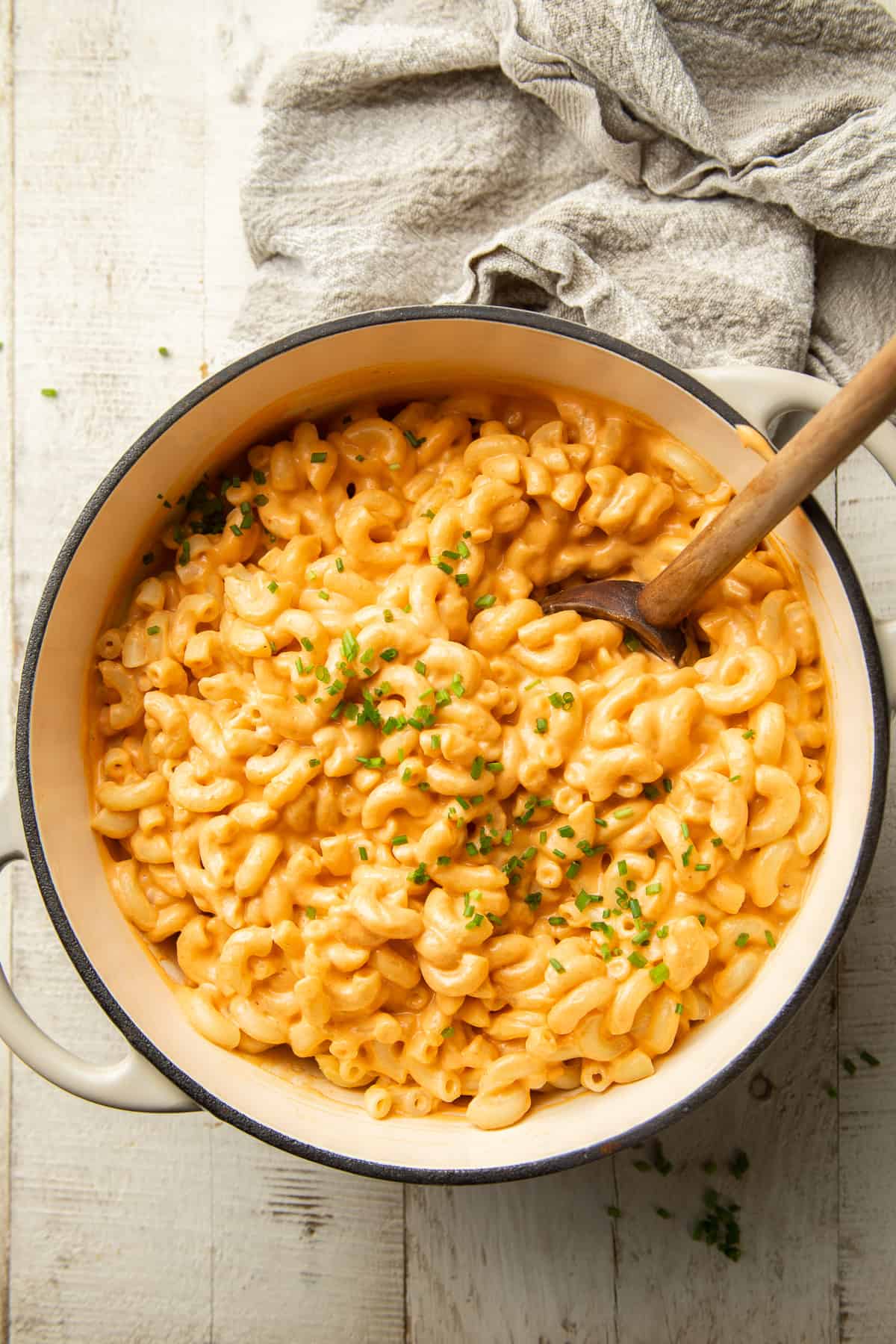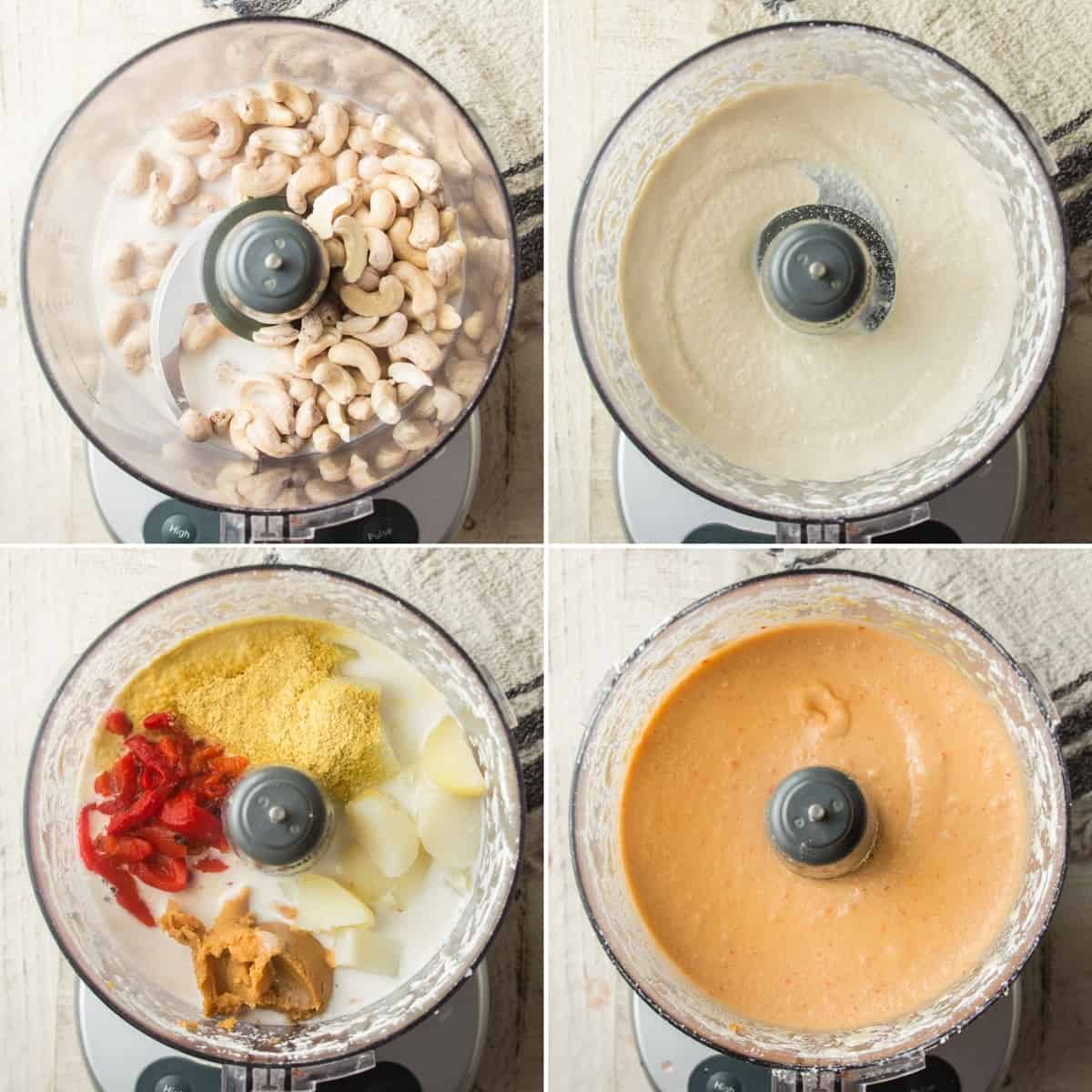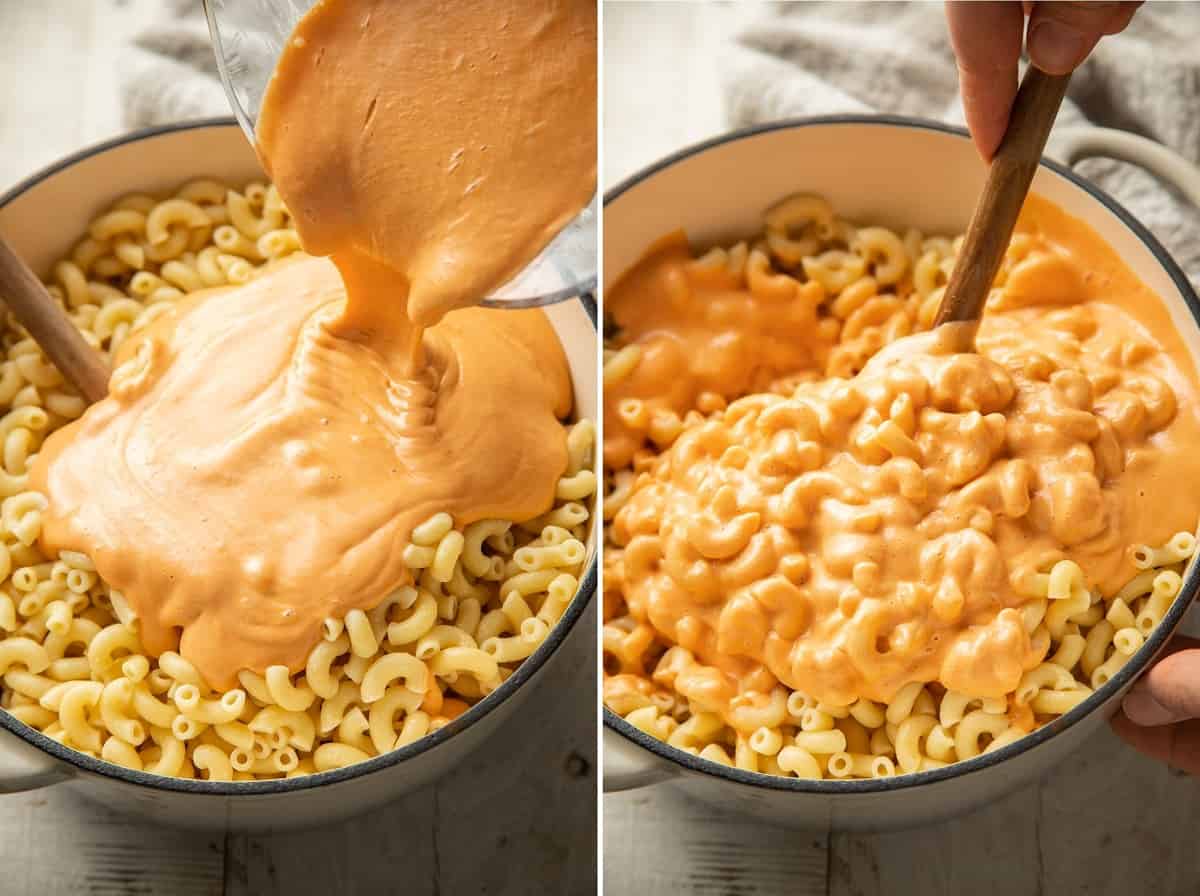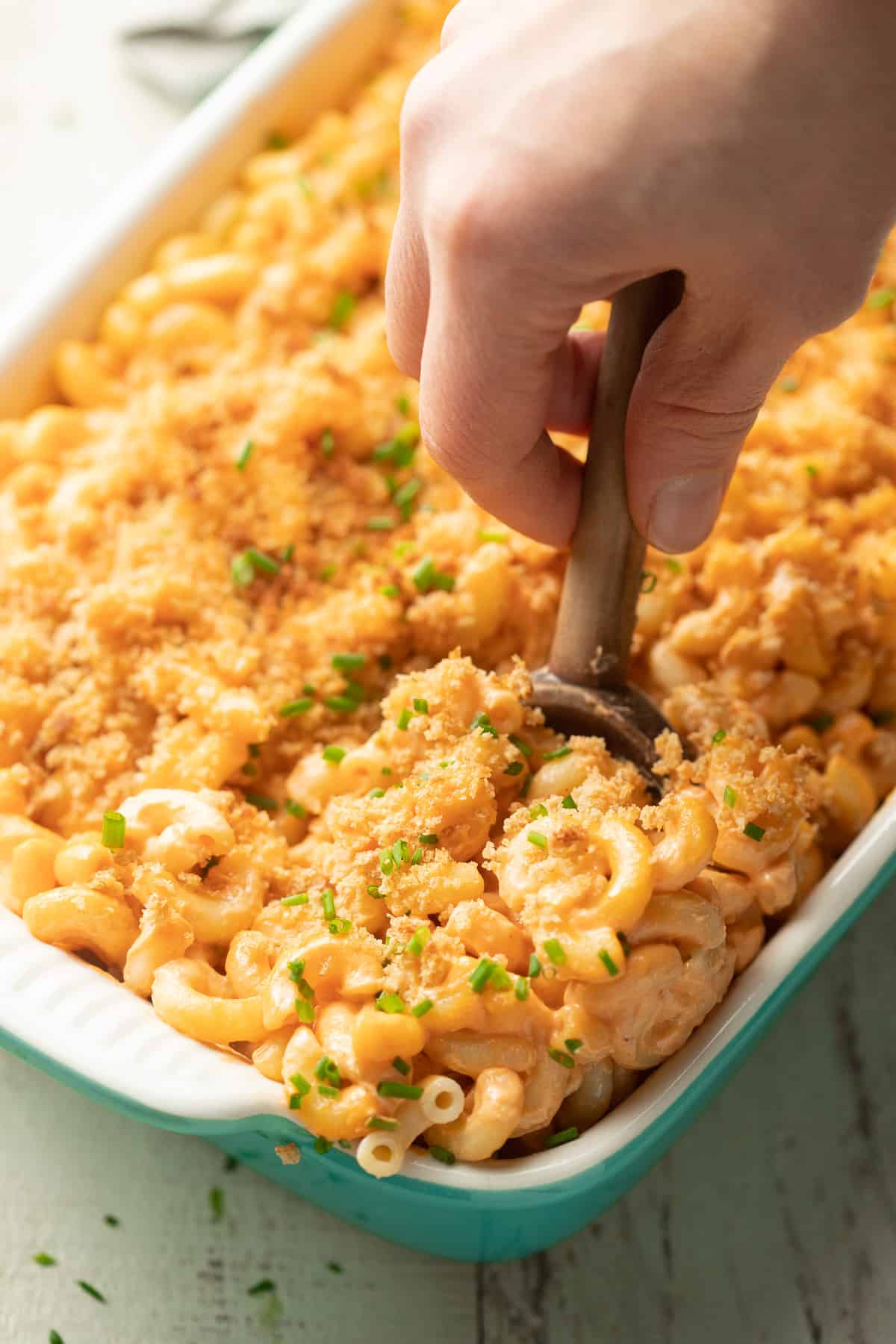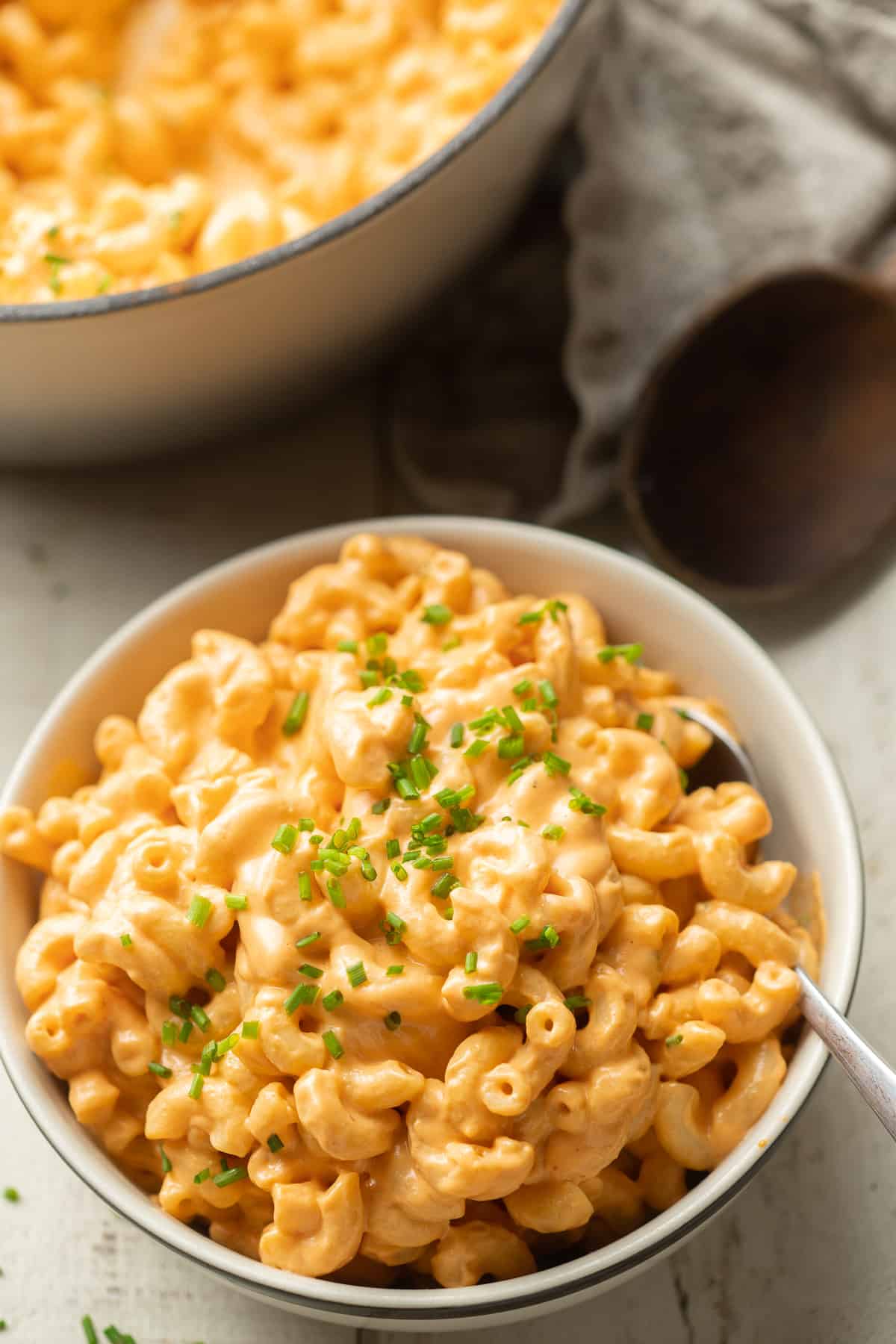To say that I’ve made a lot of vegan mac and cheese over the years is an understatement. I’ve tried so many recipes! I’ve also tried to develop so many recipes! And while many were good, it took a while before I really felt like I nailed it.
Why This Recipe Works
Coming up with a dairy-free mac & cheese recipe presents two big challenges: texture and flavor! Mac & cheese needs to be creamy and have that characteristic tangy, cheesy flavor that we all love so much. A lot of recipes fall flat for me in one or both of these departments. Not this one! Texture. Raw cashews blend up super creamy and have a surprisingly neutral flavor, which makes them a great stand-in for dairy, and an awesome cheese base. Cashews on their own can be overly heavy though, and I find a lot of cashew-based sauces to lack body. So we’re also using a potato. The potato will smooth out the sauce and actually give it a bit of stretch, just like cheese. Flavor. This recipe uses a mix of ingredients to recreate the cheesy flavor we all love so much. Some of them you might have guessed: nutritional yeast, salt, and vinegar, which you’ll find in most vegan mac and cheese recipes. But we’ve got a few secret weapons here as well, including miso paste, which is fermented (like cheese is!) to give the sauce touch of umami, roasted red peppers for a touch of smokiness, and hot sauce which adds some zip.
Ingredient Notes
Dried elbow macaroni. You can absolutely substitute another type of dried pasta if you’d like. I recommend going for something on the small side. Shells or rotini would be great choices!Raw cashews. It’s important that the cashews are raw. Roasting them brings out their nutty flavor, so if you use roasted cashews your mac will end up tasting like cashew butter, rather than cheesy deliciousness.Non-dairy milk. Just about any variety that’s unflavored and unsweetened will work. Try soy milk, almond milk, or cashew milk.A potato. A regular old russet potato works best for this recipe, but you can substitute a couple of red or gold potatoes if that’s what you have on hand.Miso paste. Look for miso paste in the international foods section of your supermarket. It can be omitted if you absolutely don’t want to use it or can’t find it, but you’ll need to increase the amount of salt in the dish by quite a bit. White miso paste is preferable, but other varieties will work just fine.Nutritional yeast. Not to be confused with baking yeast! Nutritional yeast is a completely different ingredient, and it adds savory, cheesy flavor to our vegan mac & cheese sauce. Look for it in the natural foods section of your supermarket.Roasted red peppers. Red wine vinegar. You can use another type of vinegar if needed, such as white vinegar or white wine vinegar.Hot sauce. This ingredient is also optional, but highly recommended. Believe it or hot, hot sauce will make your cheese sauce taste more cheesy. You only need a small amount, and if if you choose a mild brand you won’t notice much in the way of heat. I’m a big fan of Cholula in this dish.Garlic powder.Onion powder.Salt.Vegan butter. Butter is optional in this recipe, but I recommend using it. Look for vegan butter near where the regular butter is sold at your supermarket. Miyoko’s and Earth Balance are a couple of popular brands.
How It’s Made
The following is a detailed photo tutorial on how to make this dish. Scroll all the way down if you’d like to skip right to the recipe!
Prep by peeling, dicing and boiling your potato until it’s soft.Make your sauce. Place the cashews into a food processor bowl with some non-dairy milk. Blend them to a smooth paste. Be patient! This can take a few minutes depending on how powerful your blending device is.Add the potato, along with some more milk, nutritional yeast, miso, roasted red peppers, vinegar, hot sauce, onion and garlic powders, and salt.Blend everything again until the sauce is smooth. Give it a taste and adjust the seasonings to your liking.
Tip for high-powered blending devices: Take this shortcut if you have a high-powered blender such as a Vitamix or Blendtec. Instead of soaking your cashews for hours, just boil them with your potato, then blend everything for the sauce at once.
Boil your pasta, and when it’s done, drain and return it to the pot, then toss it with a bit of vegan butter. Pour in the sauce and stir up your mac until it’s smooth and creamy. You can thin the sauce with some extra milk if you’d like.
Tip: If you find the macaroni has cooled down too much, just place the pot on the stove and heat it back up, stirring all the while and adding more non-dairy milk as needed.
Variation: Baked Vegan Mac & Cheese
Okay, this isn’t technically baked. I generally don’t recommend baking recipes with cashew-based sauces, because they tend to dry out too much. Instead, broil it. Preheat your broiler. Make sure your mac & cheese is hot before getting started. If not, heat it up on the stove, adding non-dairy milk as the sauce dries. You want it to be very hot and very creamy before broiling. Once it’s hot, place your macaroni into a baking dish or oven-safe skillet. Sprinkle the top with some breadcrumbs — most panko breadcrumbs are vegan. You can season them with some spices and salt if you like. Pop it into the oven and broil until the top is browned and crispy. Keep a close eye on it, as things burn quickly under the broiler!
Leftovers & Storage
Leftover vegan mac & cheese will keep in a sealed container in the fridge for 3 to 4 days. The sauce will thicken up during storage, so you may want to add some non-dairy milk or water when you reheat it. I don’t recommend freezing this dish.
More Vegan Comfort Food Recipes
Vegan MeatloafVegan Cabbage RollsVegan Mushroom StroganoffVegan Beef StewLentil Meatballs
Like this recipe? If so, be sure to follow me on Facebook, Pinterest or Instagram, or subscribe to my newsletter. And please stop back and leave me a review and rating below if you make it!
